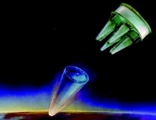 The Pentagon is considering acquiring up to four types of Reliable Replacement Warheads (RRW), twice as many as reported so far, according to an overview discovered by the Federation of the American Scientists on a Pentagon web site.
The Pentagon is considering acquiring up to four types of Reliable Replacement Warheads (RRW), twice as many as reported so far, according to an overview discovered by the Federation of the American Scientists on a Pentagon web site.
The Department of Energy told Congress in April that Los Alamos National Laboratory and Lawrence Livermore National Laboratory were working on “an RRW design” for completion later in 2006. The Washington Post added last month that a Senate subcommittee had added $10 million to next year’s budget to fund a design of a second RRW.
According to the new DOD overview, which looks beyond 2030, the future nuclear weapons stockpile would be made up of 4-6 different types of warheads (down from nine types today). A decision would be made mid-next decade about whether to have a mix of RRWs and existing warhead types or transition to an all RRW-stockpile.
In an apparent response to the Bush administration’s decision to reduce reliance of reserve warheads and instead transition to a “responsive infrastructure” that will produce warheads when needed, the DOD plan envisions “steady-state production of warheads for deployment” in the long term.
The plan also forecasts decisions on developments of warheads for the next generation of nuclear weapon delivery systems (missiles and aircraft).
The U.S. nuclear stockpile currently contains approximately 10,000 nuclear warheads of nine principle designs: B61, W62, W76, W78, W80, B83, W84, W87 and W88. The Bush administration has decided to reduce the total stockpile “almost in half” which is estimated to leave a stockpile of some 6,000 warheads in 2012.
This report outlines a framework relying on “Cooperative Technical Means” for effective arms control verification based on remote sensing, avoiding on-site inspections but maintaining a level of transparency that allows for immediate detection of changes in nuclear posture or a significant build-up above agreed limits.
The grant comes from the Carnegie Corporation of New York (CCNY) to investigate, alongside The British American Security Information Council (BASIC), the associated impact on nuclear stability.
Satellite imagery of RAF Lakenheath reveals new construction of a security perimeter around ten protective aircraft shelters in the designated nuclear area, the latest measure in a series of upgrades as the base prepares for the ability to store U.S. nuclear weapons.
It will take consistent leadership and action to navigate the complex dangers in the region and to avoid what many analysts considered to be an increasingly possible outcome, a nuclear conflict in East Asia.